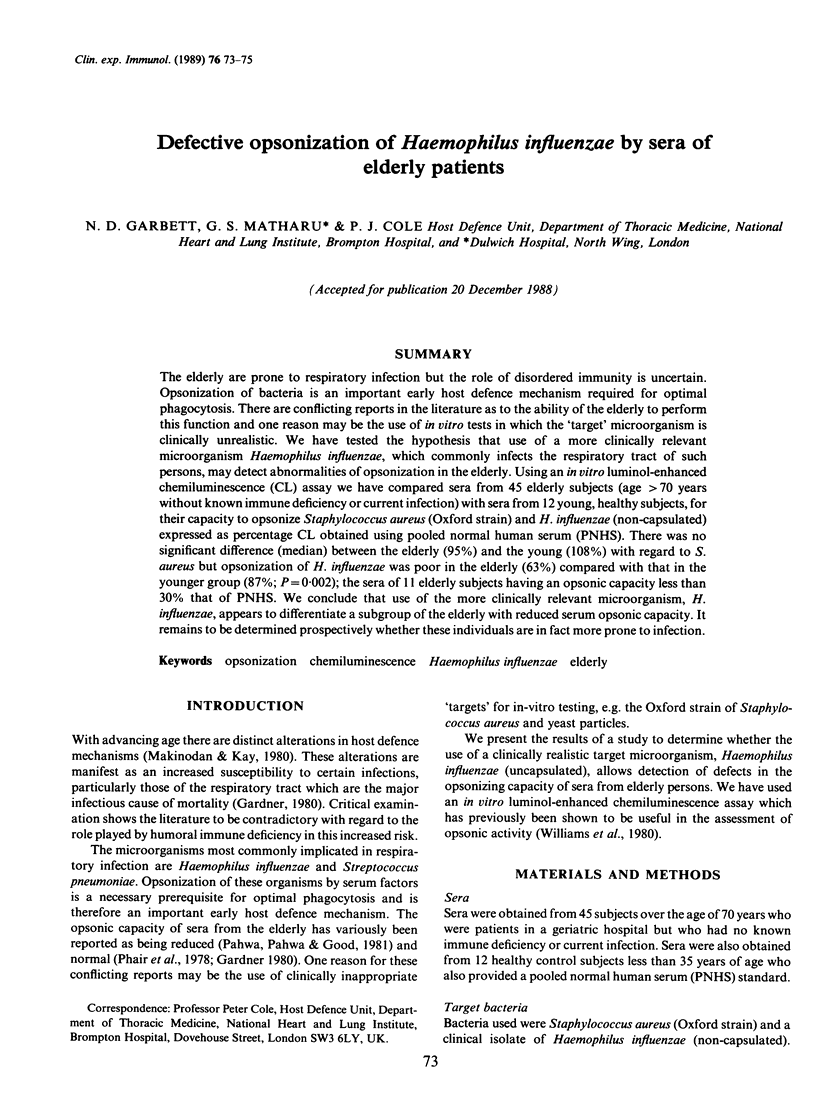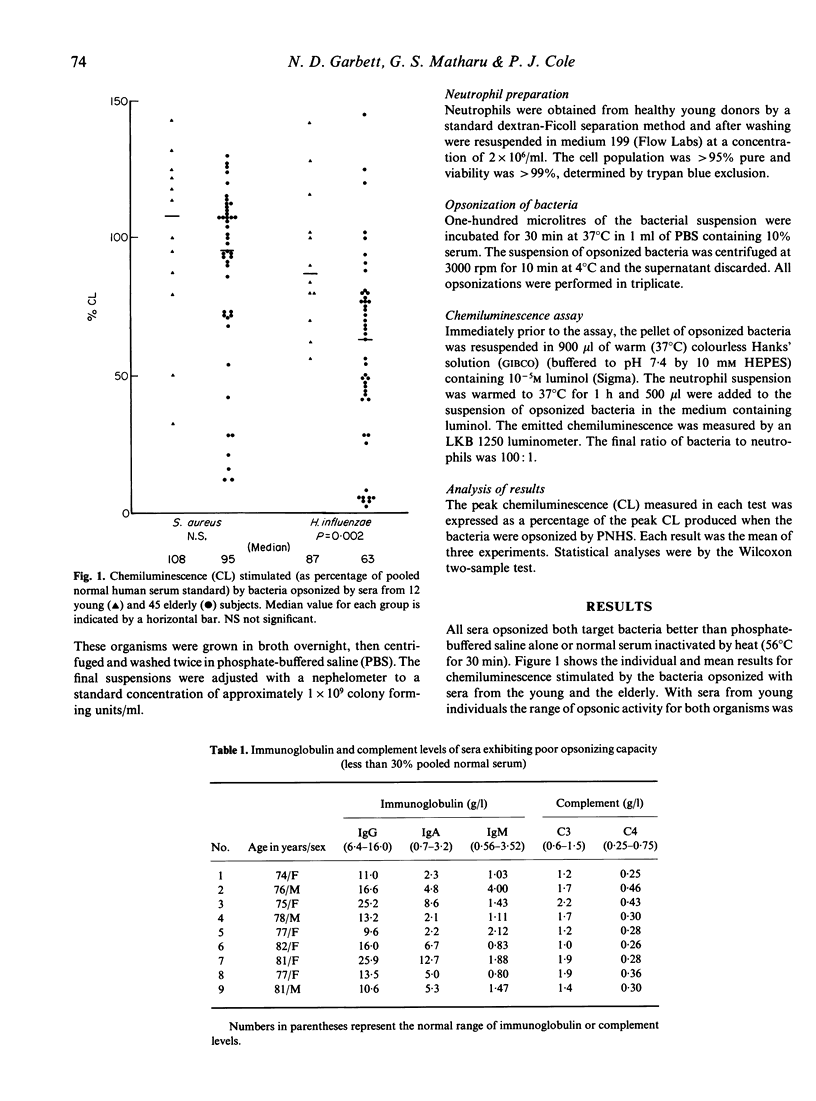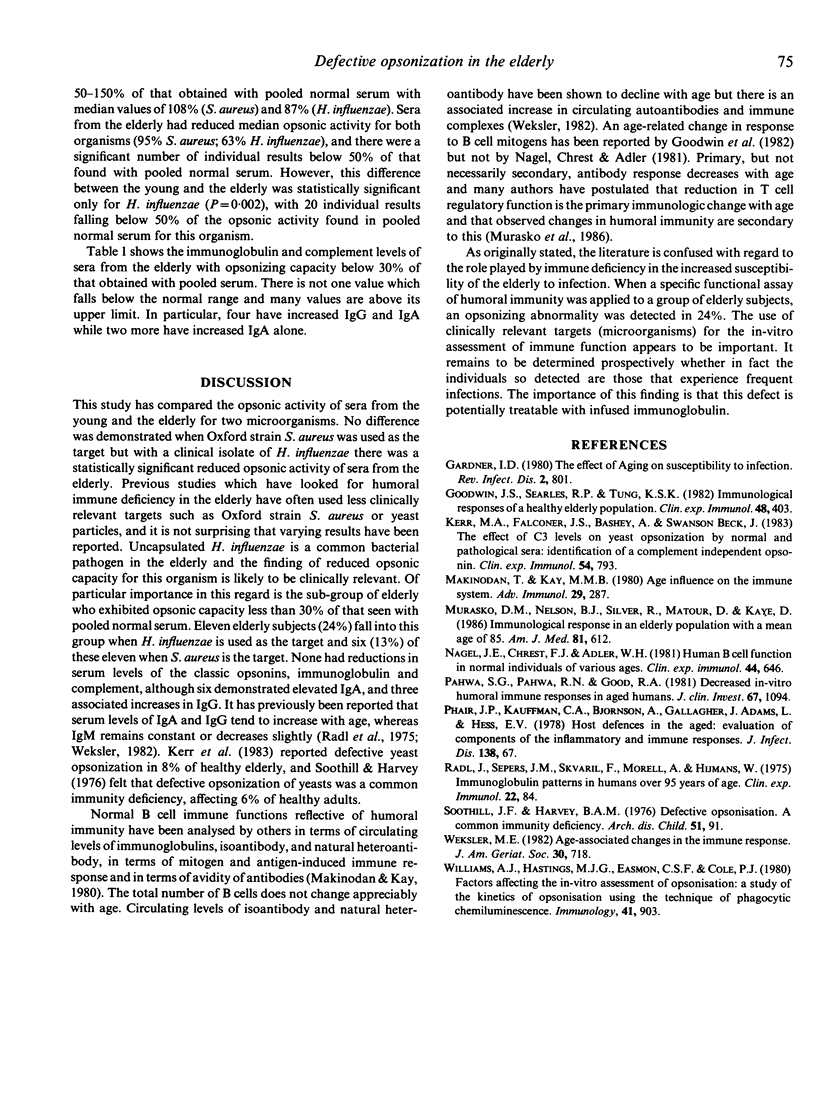Abstract
The elderly are prone to respiratory infection but the role of disordered immunity is uncertain. Opsonization of bacteria is an important early host defence mechanism required for optimal phagocytosis. There are conflicting reports in the literature as to the ability of the elderly to perform this function and one reason may be the use of in vitro tests in which the 'target' microorganism is clinically unrealistic. We have tested the hypothesis that use of a more clinically relevant microorganism Haemophilus influenzae, which commonly infects the respiratory tract of such persons, may detect abnormalities of opsonization in the elderly. Using an in vitro luminol-enhanced chemiluminescence (CL) assay we have compared sera from 45 elderly subjects (age greater than 70 years without known immune deficiency or current infection) with sera from 12 young, healthy subjects, for their capacity to opsonize Staphylococcus aureus (Oxford strain) and H. influenzae (non-capsulated) expressed as percentage CL obtained using pooled normal human serum (PNHS). There was no significant difference (median) between the elderly (95%) and the young (108%) with regard to S. aureus but opsonization of H. influenzae was poor in the elderly (63%) compared with that in the younger group (87%; P = 0.002); the sera of 11 elderly subjects having an opsonic capacity less than 30% that of PNHS. We conclude that use of the more clinically relevant microorganism, H. influenzae, appears to differentiate a subgroup of the elderly with reduced serum opsonic capacity. It remains to be determined prospectively whether these individuals are in fact more prone to infection.
Full text
PDF


Selected References
These references are in PubMed. This may not be the complete list of references from this article.
- Gardner I. D. The effect of aging on susceptibility to infection. Rev Infect Dis. 1980 Sep-Oct;2(5):801–810. doi: 10.1093/clinids/2.5.801. [DOI] [PubMed] [Google Scholar]
- Goodwin J. S., Searles R. P., Tung K. S. Immunological responses of healthy elderly population. Clin Exp Immunol. 1982 May;48(2):403–410. [PMC free article] [PubMed] [Google Scholar]
- Kerr M. A., Falconer J. S., Bashey A., Beck J. S. The effect of C3 levels on yeast opsonization by normal and pathological sera: identification of a complement independent opsonin. Clin Exp Immunol. 1983 Dec;54(3):793–800. [PMC free article] [PubMed] [Google Scholar]
- Makinodan T., Kay M. M. Age influence on the immune system. Adv Immunol. 1980;29:287–330. doi: 10.1016/s0065-2776(08)60047-4. [DOI] [PubMed] [Google Scholar]
- Murasko D. M., Nelson B. J., Silver R., Matour D., Kaye D. Immunologic response in an elderly population with a mean age of 85. Am J Med. 1986 Oct;81(4):612–618. doi: 10.1016/0002-9343(86)90546-2. [DOI] [PubMed] [Google Scholar]
- Nagel J. E., Crest F. J., Adler W. H. Human B cell function in normal individuals of various ages. 1. In vitro enumeration of pokeweed-induced peripheral blood lymphocyte immunoglobulin-synthesizing cells and the comparison of the results with numbers of peripheral B and T cells, mitogen responses, and levels of serum immunoglobulins. Clin Exp Immunol. 1981 Jun;44(3):646–653. [PMC free article] [PubMed] [Google Scholar]
- Pahwa S. G., Pahwa R. N., Good R. A. Decreased in vitro humoral immune responses in aged humans. J Clin Invest. 1981 Apr;67(4):1094–1102. doi: 10.1172/JCI110122. [DOI] [PMC free article] [PubMed] [Google Scholar]
- Radl J., Sepers J. M., Skvaril F., Morell A., Hijmans W. Immunoglobulin patterns in humans over 95 years of age. Clin Exp Immunol. 1975 Oct;22(1):84–90. [PMC free article] [PubMed] [Google Scholar]
- Soothill J. F., Harvey B. A. Defective opsonization. A common immunity deficiency. Arch Dis Child. 1976 Feb;51(2):91–99. doi: 10.1136/adc.51.2.91. [DOI] [PMC free article] [PubMed] [Google Scholar]
- Weksler M. E. Age-associated changes in the immune response. J Am Geriatr Soc. 1982 Nov;30(11):718–723. doi: 10.1111/j.1532-5415.1982.tb01988.x. [DOI] [PubMed] [Google Scholar]
- Williams A. J., Hastings M. J., Easmon C. S., Cole P. J. Factor affecting the in vitro assessment of opsonization: a study of the kinetics of opsonization using the technique of phagocytic chemiluminescence. Immunology. 1980 Dec;41(4):903–911. [PMC free article] [PubMed] [Google Scholar]


